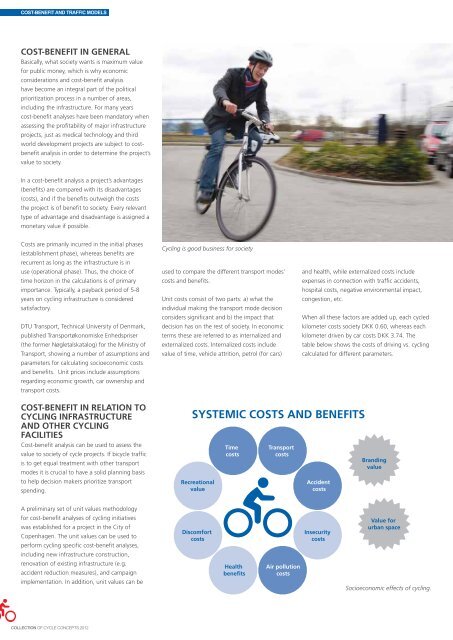Collection of Cycle Concepts 2012.pdf - Fietsberaad
Collection of Cycle Concepts 2012.pdf - Fietsberaad
Collection of Cycle Concepts 2012.pdf - Fietsberaad
You also want an ePaper? Increase the reach of your titles
YUMPU automatically turns print PDFs into web optimized ePapers that Google loves.
COST-BENEFIT AND TRAFFIC MODELS<br />
COST-BENEFIT IN GENERAL<br />
Basically, what society wants is maximum value<br />
for public money, which is why economic<br />
considerations and cost-benefit analysis<br />
have become an integral part <strong>of</strong> the political<br />
prioritization process in a number <strong>of</strong> areas,<br />
including the infrastructure. For many years<br />
cost-benefit analyses have been mandatory when<br />
assessing the pr<strong>of</strong>itability <strong>of</strong> major infrastructure<br />
projects, just as medical technology and third<br />
world development projects are subject to costbenefit<br />
analysis in order to determine the project’s<br />
value to society.<br />
In a cost-benefit analysis a project’s advantages<br />
(benefits) are compared with its disadvantages<br />
(costs), and if the benefits outweigh the costs<br />
the project is <strong>of</strong> benefit to society. Every relevant<br />
type <strong>of</strong> advantage and disadvantage is assigned a<br />
monetary value if possible.<br />
Costs are primarily incurred in the initial phases<br />
(establishment phase), whereas benefits are<br />
recurrent as long as the infrastructure is in<br />
use (operational phase). Thus, the choice <strong>of</strong><br />
time horizon in the calculations is <strong>of</strong> primary<br />
importance. Typically, a payback period <strong>of</strong> 5-8<br />
years on cycling infrastructure is considered<br />
satisfactory.<br />
DTU Transport, Technical University <strong>of</strong> Denmark,<br />
published Transportøkonomiske Enhedspriser<br />
(the former Nøgletalskatalog) for the Ministry <strong>of</strong><br />
Transport, showing a number <strong>of</strong> assumptions and<br />
parameters for calculating socioeconomic costs<br />
and benefits. Unit prices include assumptions<br />
regarding economic growth, car ownership and<br />
transport costs.<br />
Cycling is good business for society<br />
used to compare the different transport modes’<br />
costs and benefits.<br />
Unit costs consist <strong>of</strong> two parts: a) what the<br />
individual making the transport mode decision<br />
considers significant and b) the impact that<br />
decision has on the rest <strong>of</strong> society. In economic<br />
terms these are referred to as internalized and<br />
externalized costs. Internalized costs include<br />
value <strong>of</strong> time, vehicle attrition, petrol (for cars)<br />
and health, while externalized costs include<br />
expenses in connection with traffic accidents,<br />
hospital costs, negative environmental impact,<br />
congestion, etc.<br />
When all these factors are added up, each cycled<br />
kilometer costs society DKK 0.60, whereas each<br />
kilometer driven by car costs DKK 3.74. The<br />
table below shows the costs <strong>of</strong> driving vs. cycling<br />
calculated for different parameters.<br />
COST-BENEFIT IN RELATION TO<br />
CYCLING INFRASTRUCTURE<br />
AND OTHER CYCLING<br />
FACILITIES<br />
Cost-benefit analysis can be used to assess the<br />
value to society <strong>of</strong> cycle projects. If bicycle traffic<br />
is to get equal treatment with other transport<br />
modes it is crucial to have a solid planning basis<br />
to help decision makers prioritize transport<br />
spending.<br />
SYSTEMIC COSTS AND BENEFITS<br />
Recreational<br />
value<br />
Time<br />
costs<br />
Transport<br />
costs<br />
Accident<br />
costs<br />
Branding<br />
value<br />
A preliminary set <strong>of</strong> unit values methodology<br />
for cost-benefit analyses <strong>of</strong> cycling initiatives<br />
was established for a project in the City <strong>of</strong><br />
Copenhagen. The unit values can be used to<br />
perform cycling specific cost-benefit analyses,<br />
including new infrastructure construction,<br />
renovation <strong>of</strong> existing infrastructure (e.g.<br />
accident reduction measures), and campaign<br />
implementation. In addition, unit values can be<br />
Discomfort<br />
costs<br />
Health<br />
benefits<br />
Air pollution<br />
costs<br />
Insecurity<br />
costs<br />
Value for<br />
urban space<br />
Socioeconomic effects <strong>of</strong> cycling.



